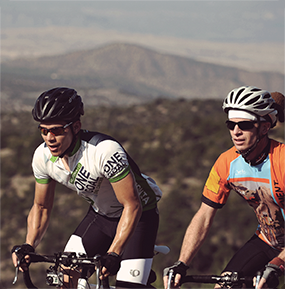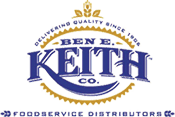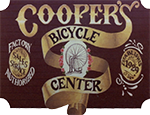If you do not remember your username or password, the system can send them to you. Please provide the email address you registered with.
Error: Please check your email address and try again.
The event you requested is not currently published.
Thank you to our premier national sponsors
Thank you to our local sponsors
If you are interested in sponsoring the 2016 Bike MS: The Road Divided, please contact Sarah Flowers for details.
Presenting Sponsor
Gold Sponsors
Silver Sponsors
Bronze Sponsors
Bike Shop Sponsors
Being safe and prepared is a priority.
Safety
The safety of our cyclists is the number one priority at the . Each year, tens of thousands of participants join in approximately 100 rides across the nation. There is a great mix of riders with different experience and skill levels on the road together. To help ensure that everyone has a great ride and arrives safely at the finish line, we work hard to create a proactive approach to safety.
Safety isn't just about wearing your helmet and knowing the rules of the road. Those are very important measures, but cycling safety involves much more. Bike safety encompasses a wide variety of topics including bike maintenance, group riding skills, cycling etiquette, and much more.
The National MS Society strongly encourages you to review the compiled bike safety information resources below. This information will help you prepare and practice safe cycling skills.
Ride safely and have fun because there's nothing like crossing the finish line and celebrating with your team! Don't just ride, Bike MS.
LAB
Education has been a core activity of the League's since the late 1970's. It is designed to work with experience levels ranging from brand-new bicyclists up to experienced bicyclists who want to refine their skills and teach others.
League of American BicyclistsAdditional Safety Resources:
- Bike MS Safety Brochure
- For Youth Riders: Cycling for Minors 101 Brochure
-
NHTSA Bicycle Safety Tips Video:

Training for an Endurance Ride
The is more than just a ride; it's also the anticipation and preparation for an incredible experience. Training is a journey in itself and is essential to a successful ride. Training will help you to prepare mentally and physically.
Official Bike Stores
Official Bike Stores are the official bike store partners of the National MS Society and the . They are major supporters and partners with the National MS Society in our efforts to raise awareness of multiple sclerosis and raise funds to support research, programs, services, and advocacy for those living with MS. In addition to sales, parts, and labor, Official Bike Stores will be able to get you up-to-speed on training programs underway in your area. View our Official Bike Stores page to find our partner nearest to you.
Official Bike StoresTraining Peaks
We're pleased to introduce you to TrainingPeaks, the official training software of Bike MS! We are excited about this partnership and invite you to experience it.
Training PeaksIf you prefer a downloadable and printable training guide, we have that too: Bike MS Training Guide
Recommended Rides
Be sure to click the "Recommended Rides" tab at the top of the page to view other training rides from around the region served by the .
Recommended Rides
Check out upcoming training rides in your area here!
Cycling Tips
Cyclists need to have basic bike-handling skills and safety knowledge in order to keep themselves and others around them safe, especially while participating in group cycling activities, like a bike ride. Our focus is to provide a high quality, safe and fun bicycling experience. For this reason, the National MS Society has partnered with the League of American Bicyclists to provide our cyclists with the knowledge and resources to cycle safety.
Table of Contents:
- Tips for Riding in Wet Conditions
- ABC Quick Check
- Basics of Riding in a Group
- Helmet Smart
- Bicycle Laws
- Helpful Tips
- Know the Lingo
- Special Situations
Tips for Riding in Wet Conditions:
Cornering
- Make turns slowly and consistently (no jerky movements)
- Keep your weight on the outside pedal in the 6 o'clock position
- If you need to brake in a turn, apply the brakes slowly
Braking
- Remember: Water on the rims will lubricate your brake system, making it hard to stop
- Apply the brakes lightly to clean off the rims before you need to stop
- Allow a greater distance for stopping
Hazards
- Bridges, metal grates, painted lines, manhole covers, and crosswalks can be very slick
- Avoid puddles; they may conceal deep potholes
- Remember that, during the first few minutes of rain, oil seeps from the roadway, making it very slick. Ride accordingly
Protect Yourself
- Visibility can be limited during a storm. Wear bright clothing
- Keep your eyes free of debris with yellow or clear lenses in your glasses
- Wear waterproof clothing that is breathable, with layers underneath
Protect Your Bike
- Front and rear fenders will keep you and your bike dry
- Lube your chain before and after a wet ride to replace the lube that washed off
- Drip chain lube down into your brake and shifter cables to avoid rust
Important reminder! Always carry the following items:
- Identification
- Emergency contact information
- Insurance card
- Any important health information
- NOTE: The use of headphones, cell phones, radios, or similar devices while riding is NOT permitted.
ABC Quick Check
All cyclists are responsible for keeping their riding equipment in good working order, so get into the habit of checking your equipment before every ride. Small adjustments can make a significant difference in your experience. The "ABC Quick Check" is an thorough-yet-brief bicycle safety check.
- A is for Air
Check your wheels for worn tires, loose spokes, and warped rims; and check your tires for proper inflation. - B is for Brakes
Check brakes for proper function, cable tautness, worn pads, frayed cables, and alignment of the pads with the rims. - C is for Cranks, Chain, and Cassette
Check your pedals and cranks for tightness. Check for chain looseness and bad links; clean regularly and oil with bicycle chain lubricant. Check the derailleur for worn cogs and needed adjustment. Check that your gears change smoothly. - Quick is for Quick Releases
Check to ensure that the wheels are clamped securely in the drop-outs before each ride. - Check
Check your helmet for cracks and make sure it fits properly. Check your shoes for tight cleats and to ensure the straps and buckles are in good repair. Make sure your bicycle saddle is at the right height and the bolt is secured. Check your handlebars for looseness at the headset and stem.
The Basics of Riding in a Group
Group riding takes practice. Riding with other cyclists all around you may cause you to feel trapped. Relax; it is most important to create your own safety zone. This may vary depending on the speed and ability level of the people you are with, so be flexible. Let others know of your anxiety – they may also be new at this.
Your responsibility in a pack includes:
- Be aware of others around you
- Communicate well in advance; use gestures in combination with verbal commands
- Ride with your head up; look down the road, not at the person in front of you
- Maintain control and speed of your bike, even going downhill
- Know your limits: Crashes can occur when inexperienced riders do not have bike-handling skills to make quick decisions in a pack
- Safety starts with you: Group mentality is not always safe; expect to stop at all red lights and stop signs—it is the law!—and each cyclist is responsible for verifying that the intersection is clear
- Adjust your safety zone to fit the conditions of the road, weather, and traffic
- Always plan an escape route
- Never overlap your wheels with another cyclist
- Do not use aerobars in a pack
- Be aware of how weather will affect your bike; riding in wet conditions requires slower speeds and greater breaking distances
- Be respectful of other riders; help others when needed
Helmet Smart
Head injuries are a special concern for cyclists. Even falling at a slow rate of speed can cause a serious head injury. Helmets must be on your head and strapped securely while riding in the – No exceptions. Participants found not to be wearing their helmets will be disqualified from the ride and removed from the route.
Bicycle Laws
All states consider cyclists to be vehicle operators, and give them the same privileges and responsibilities as other drivers.
- Know and Obey All Traffic Laws: The golden rule of bicycling in a group is "Be Predictable"
- Stay Right: Ride in the right portion of the rightmost lane in the direction you are traveling and leave at least four feet between your handlebars and parked cars or other hazards (such as other riders); leftward movement is permitted when passing slower vehicles or preparing for a left turn
- Obey All Traffic Signs and Signals: Avoid "following the leader" through traffic signs and signals; you are required to obey all traffic signs and signals, including stopping at red lights and stop signs
- Look & Signal before You Move: Always scan behind you before changing lanes or making turns, and perform the appropriate, continuous arm signal prior to a turn or lane change (unless arm is needed to control the bike) and while stopped waiting to turn
- Two at a Time: Ride no more than two abreast and do not impede traffic (if a part of the road has been closed and dedicated to "bicycle travel only", you may ride more than two abreast)
- Hands on the Handlebars: Do not carry anything that prevents keeping your hands on the handlebars
- Pass with Care: Do not pass at intersections
Helpful Tips:
On the routes, our active route support team works to make the ride safe. Here are a few additional suggestions to help keep everyone safe on the ride:
- SAG vehicles and Motorcycle Marshals will stop for you if you are safely off the road, off your bike, and waving your bike helmet in the air
- Ride Marshals are a special team of cyclists who provide support on the rides, offering minor mechanical help along the route and monitoring cycling safety and etiquette
- Rest Stop Etiquette: All cyclists who enter a rest area must pull over, dismount, and move completely away from the road and rest-stop entrance; on exiting, move beyond the rest area and proceed with caution on the right side of the road before merging with faster cyclists
- Passing: Call out "Passing on your left!" and allow time for the cyclist being overtaken to move to the right, then pass safely; passing others and being passed occurs continuously during the ride, so you will hear this a lot!
- Mechanical Problems: Safely remove yourself from the roadway at the earliest opportunity and assess the problem. If assistance is needed, SAG and Motorcycle Marshals are on patrol to help; stand off your bike and wave your helmet in the air.
- Be Courteous: participants are privileged to ride on many trails as well as public roads, so we want to return the kindness by using no more than half the trail so as not to block the flow of other users
Know the Lingo
Group cycling has its own form of communication. The presence of road hazards, directions, and need-to-know information is relayed through the pack of riders by gestures and words. Remember to pass all communication on to the cyclist behind you in the group. Speak loudly and clearly. The following are the most common terms you may hear in group-sponsored rides:
- "On your left" – This means a rider is approaching your left side; move to the right (as able) to allow room for the other rider to pass
- "Car back" – This means a car is approaching from the rear. All riders make an effort to move to the right to allow the car to pass (in most states, the law requires cyclists to ride no more than two abreast, ensuring easier and safer passing of cyclists by automobile traffic)
- "Gravel"/"Pothole"/"Sand"/"Tracks" – Each of these messages is to alert the riders behind you of hazardous road conditions, relayed not only by words but also by the gesture of pointing to the hazard well in advance
- "Flat" – This indicates that a rider has suffered a flat tire and needs room enough to slow down and move to the right side of the road or trail for repair; offer assistance if needed
- "Slowing" – The cyclist in front of you is slowing down, so use caution and prepare to stop (the common hand signal for this is to display the palm of their hand toward riders behind them to indicate slowing and stopping)
- "Stopping" – This indicates that a rider ahead is stopping; when at a stop, do not forget to unclip from your pedals
Group communication between teams and between individual riders is vitally important to ensuring the safety of all riders. Therefore, headphones, cell phones, radios, or similar devices are NOT permitted while riding.
Special Situations
Many cyclists find that situations occur in which quick thinking and heightened bike-handling skills are required. Here are some suggestions for managing potential obstacles:
- Cars Can Be Scary: Drivers do not know your skill level, and will often not leave room when they pass; call out "car back" if you are in a group at the time, then move to the far right in a single file—"Be Predictable"
- Beware of Animals: If an animal displays aggression while riding, try to keep to one side of the animal; the right course of action depends on the situation – you may want to slow down to calm an excited animal, speed up to outrun the animal, make loud noises to perturb the animal, or attempt to distract it with a water bottle or other material on your person; if in a group, always let others know of your intentions and do not perform any action which may endanger the group
- Pedestrians and Animals Have the Right-of-Way: If a jogger/runner is overtaking you and/or your group, or if any pedestrian or animal is attempting to cross the street ahead of you, signal to the group that someone is being overtaken, then move to allow room for safe passing/crossing
Check these things after each ride, and next time you'll roll without a hitch!
5 Minute Inspection
Natasha Grief, Bicycling Magazine
Most cyclists, if they check their bikes at all, wait to do it five minutes before the group is about to start rolling. What's the point? No one's going to wait for you to remedy a cracked frame or a torn sidewall. Be one of the smart ones: Give your bike this once-over after each ride, so you're ready to go at the drop of a hat... or helmet.
Quick-Release
Check for: Side-to-side play in the wheel; QRs or skewers that aren't tight or secure
How? Make sure quick-releases are closed all the way and that bolt-on skewers are securely fastened.
On your next ride: Your wheel won't come loose and detach from your bike mid-ride.
Wheels
Check for: Trueness
How? While spinning the wheel, watch the distance between the rim and the brake pad. It should be uniform for the entire rotation. If it wobbles, the wheel needs truing. (Watch our pro true a wheel at our maintenance feature at Bicycling.com)
On your next ride: Your wobbly wheel won't lead to more serious problems, such as a shudder while descending or brake pads rubbing.
Brakes
Check for: Grit on the pads; caliper alignment
How? If your brakes feel gritty, clean the pads with a rag and degreaser; replace pads if the grooves are worn more than 50% compared to new pads. Calipers are aligned if the pads are equidistant from the rim.
On your next ride: You won't go to grab the levers only to roll right through the stop sign at the bottom of the hill.
Tires
Check for: Low tire pressure; embedded debris in the tire; slices in the tire or sidewall
How? Inflate tires to proper pressure, and carefully remove embedded debris with tweezers. A cut tire or sidewall is prone to a blowout and shouldn't be ridden; replace it.
On your next ride: Your chances of flatting will greatly decrease, and you may have prevented a nasty mid-ride blowout.
Seat Bag
Check for: Supplies you may have depleted on your ride
How? If you used something during a ride, replace it so it's there for the next ride. If your spare tube has been in there for a while, give it a quick inspection to make sure it's still intact.
On your next ride: You'll have a spare tube and CO2 cartridge to lend to the guy who didn't follow this post-ride checklist.
Cleats
Check for: Loose bolts; overall wear
How? Worn-out cleats won't engage as crisply. You'll know when they've just plain quit on you; then, it's time for new cleats. Bolts can loosen over time. If your cleat isn't secure to your shoe, tighten the bolts.
On your next ride: Your foot won't pop out without warning, and you won't tumble to the ground because you couldn't disengage your cleat.
Frame
Check for: Cracks (especially at the joints)
How? Using a rag and bike polish, wipe dirt and moisture from your frame. Look for cracks, flaking paint and other irregularities.
On your next ride: You'll either be on your bike because you didn't find a crack, or you'll be on your way to the shop for a pro evaluation. If you have a carbon-frame bike with a crack, don't mess around: Failure could be catastrophic!
Check out these additional articles to help you prepare for Bike MS!
- Trick Yourself Into Training
- The New Super Foods
- The Fix
- Join The Pack Safely
- How To Ride in the Rain
- Fit Check
Basic Bike Maintenance
Learn the basics of bike maintenance, brought to you from our friends at Bicycling Magazine: Quick & Easy Bike Maintenance (Adobe Flash Player required)




























Join Us
FacebookTwitterLinkedInYouTubePinterestMS Connection